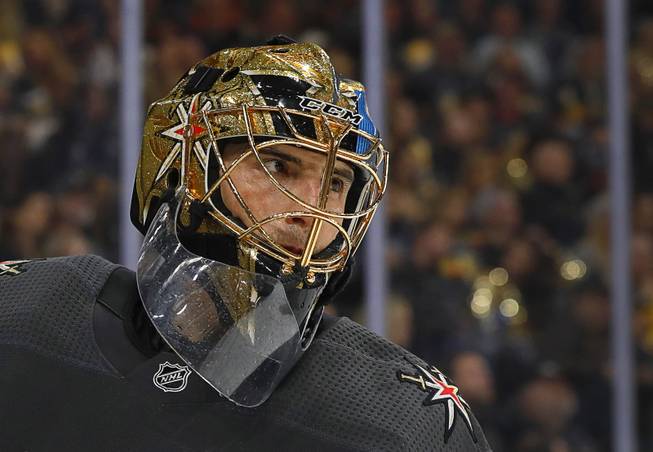
Golden Knights goaltender Marc-Andre Fleury is shown during a break in the second period of a game against the Nashville Predators at T-Mobile Arena Tuesday, Oct. 15, 2019.
Thursday, Oct. 24, 2019 | 2 a.m.
Related coverage
The Golden Knights defense was exposed Monday when the Flyers had six goals on 37 shots against backup Oscar Dansk, showing once again how subpar the defense has been to open the season.
Seven times in 11 games have the Golden Knights surrendered at least 35 shots to rank eighth in the league in most shots allowed per game.
But the Golden Knights (7-4-0 record) have survived their poor defense for a few reasons, especially with the Vegas offense pumping shots on the other net at an even higher rate, 34.9 shots for per game, fourth-best in the league.
Vegas is also winning the special-teams battles, killing off 90.9% of its penalties (best in the league) while converting on 25.0% of its power-play chances (tied for eighth in the league).
Then, of course, Vegas has one of the league’s best goalies in Marc-Andre Fleury. Here are some observations from the initial 11 games:
Flower Power
Any superlative you have in mind to describe Fleury is probably accurate. He’s sporting a .937 save percentage and 2.04 goals-against average that satiates the crowd of easily digestible stats, but the advanced numbers paint an even rosier picture.
Fleury leads the NHL with 5.07 goals saves above expected, according to Evolving Hockey, which measures the quality of shots faced and produces the number of goals that player has prevented. To compare it to the league average, Fleury also tops that, where his 8.06 goals saved above average is more than two goals better than the second-place goalie.
Fleury has kept the Golden Knights in games. He hasn't had a bad game yet this year, with the 29-save shutout on Saturday the crowning achievement. But the four goals allowed on 73 shots on back-to-back nights to the Flames and Kings is perhaps just as impressive.
Mark Stone is who we thought he was … sort of
Stone’s point output after the trade last year was maybe disappointing for those who expected a world-beater to come in and dominate right away. He wasn’t bad — 11 points in 18 regular season games — and turned it on in the playoffs.
This year though, he’s been producing points at an elite rate. Stone has 14 points in 11 games, good for sixth in the league and third among wingers. That’s a 104-point pace, which would shatter his career-high of 73 set last season.
What’s interesting is that Stone’s on-ice possession numbers have not been good yet. The Golden Knights are just barely on the plus in Corsi, expected goals and scoring chances with Stone on the ice at 5-on-5 (and were on the negative side before a strong game Tuesday in Chicago).
Considering Stone has been strongly positive in all those metrics every year of his career, it’s fair to expect some positive regression the rest of the way. The question is how hard his point total regresses in the remaining 70 games as well.
Shea Theodore’s power play
There was a belief this offseason that Shea Theodore would take a big step forward this year, stemming in part from the idea that he would get even more power-play time than last year. He not only has gotten more time, he’s played more relative time on the power play than almost anyone in the league.
As the Athletic pointed out before Tuesday’s game against Chicago, Theodore’s share of time on the ice with an extra man is sixth in the league, including an Oilers team whose power play runs through three players.
And the results are coming for Theodore. He has three points in 45:44 of power-play time, a rate of 3.9 points per 60 minutes. Last year he had 2.8 points per 60 minutes on the power play.
Smith’s scoring
Reilly Smith won’t finish this season with 52 goals.
Smith’s start has been a lot of fun to watch, and he netted another one Monday night on the breakaway. None of his goals has been flukes, it’s just that Smith isn’t the type of player likely to continue that pace. He’s been good for 3.86 expected goals in all situations, and his linemates William Karlsson and Jonathan Marchessault are about the same with fewer actual goals.
Smith’s career-high in goals is 25, so it’s not as if the scoring has come out of nowhere. But he has one assist this year and has never had more goals than assists. The line has been tremendous, but expect Smith to start distributing and for Karlsson and Marchessault’s totals to increase.
The hits keep coming
Last year, the Golden Knights levied 2,268 hits, or 27.7 per game. Led by Ryan Reaves and William Carrier, that hasn’t changed this season. Through 11 games they have 313 hits, or 28.5 per game.
The culprits are predictable. A year after leading the league in the category, Reaves is right back at the top this season with 51, 4.6 per game. Carrier was last year’s leader in hits per game and is fourth in total hits. Brayden McNabb is seventh.
The Golden Knights have had a steady mix of speed and skill at the top of their lineup and brute force at the bottom. It’s served them well through the first two years of their existence, and that doesn’t appear to be changing anytime soon.

Join the Discussion:
Check this out for a full explanation of our conversion to the LiveFyre commenting system and instructions on how to sign up for an account.
Full comments policy